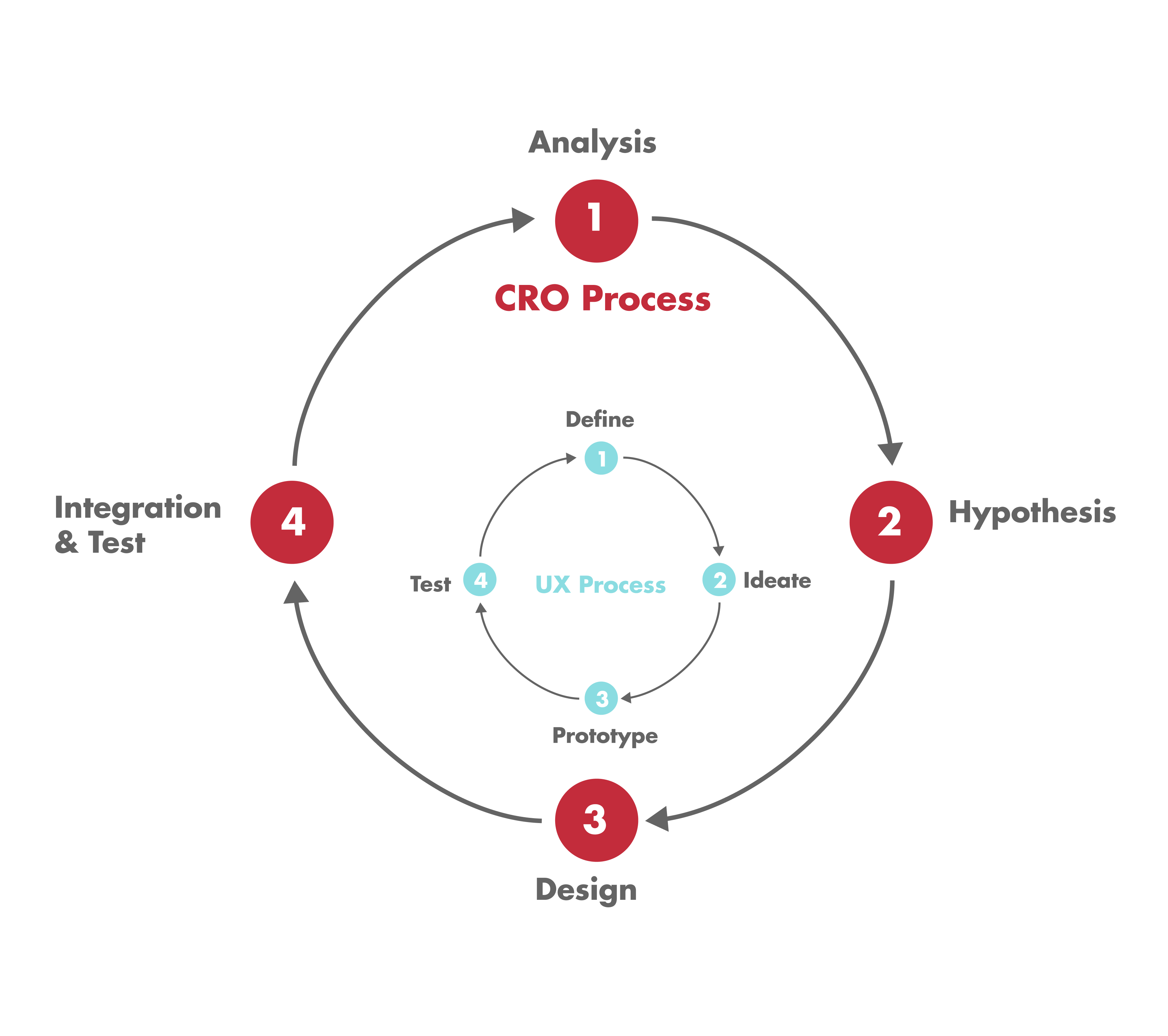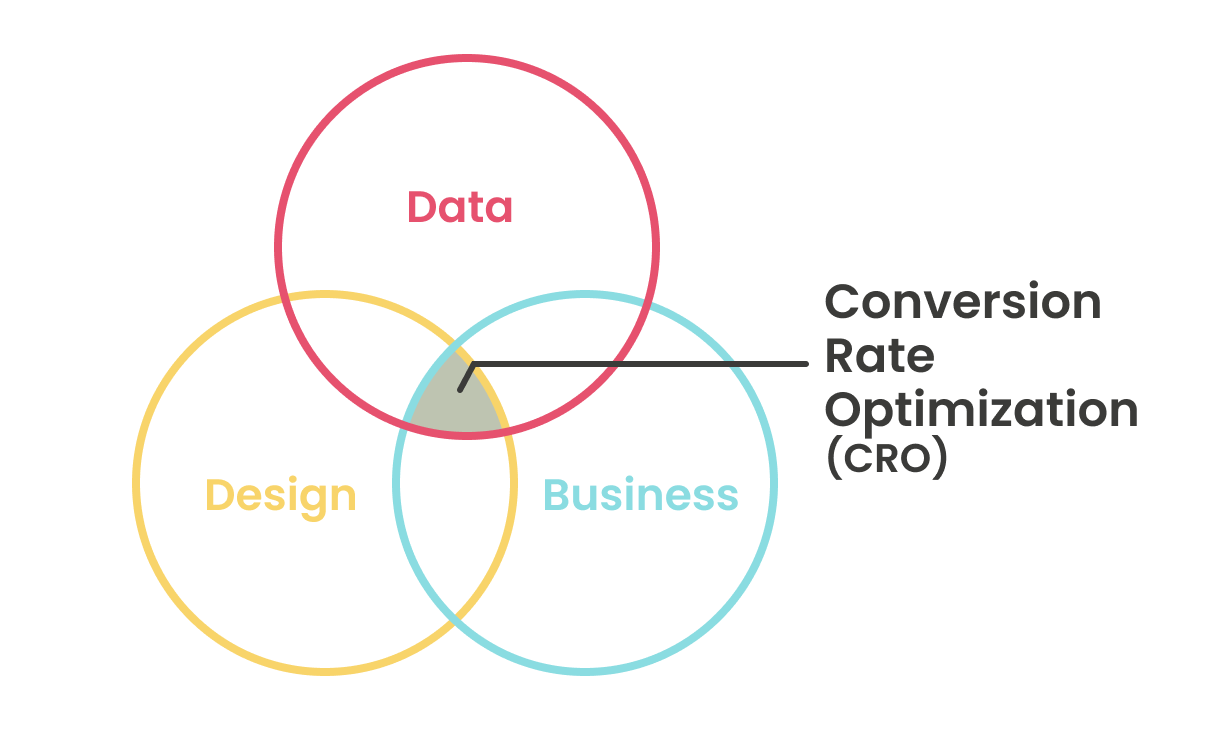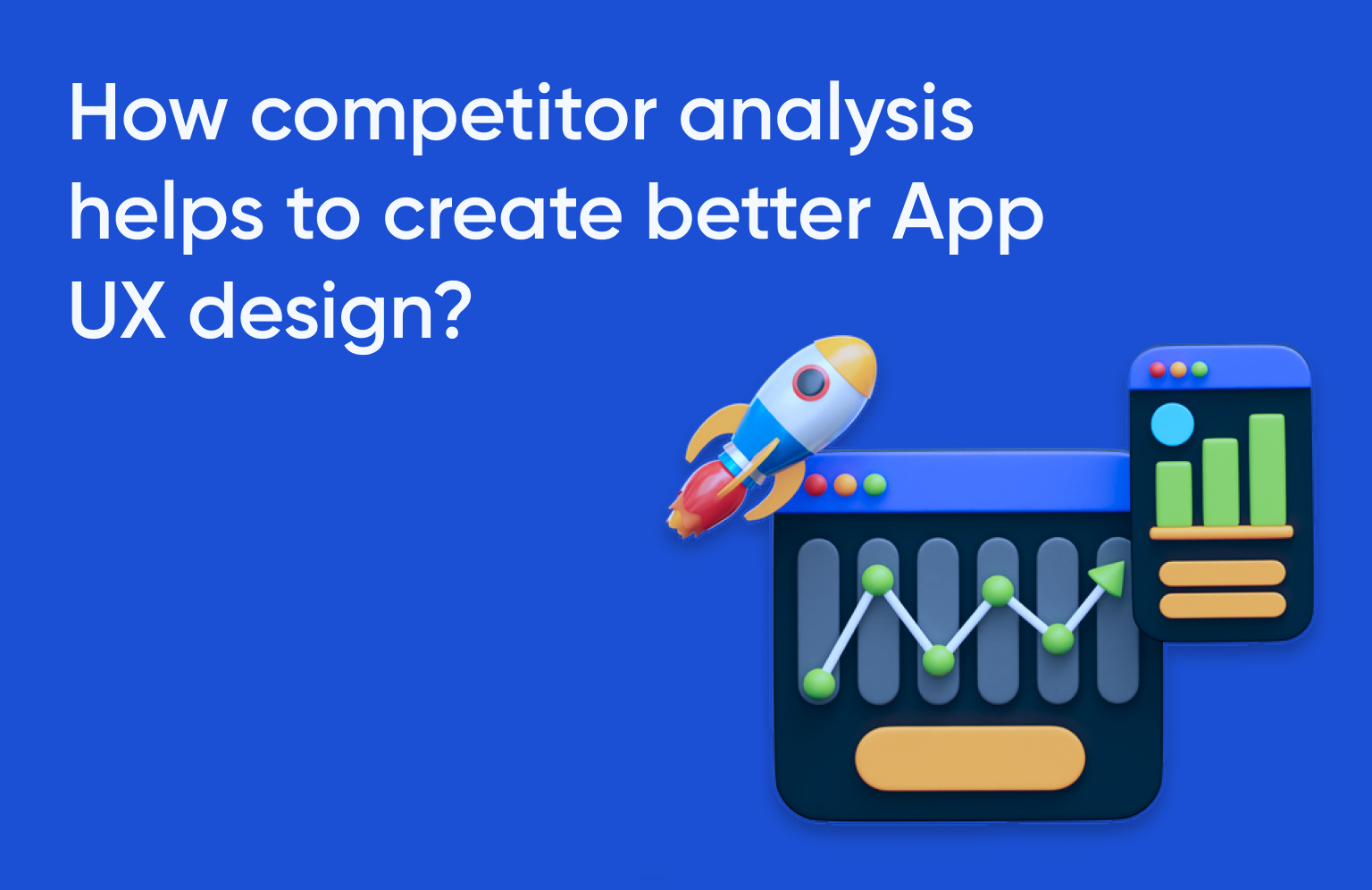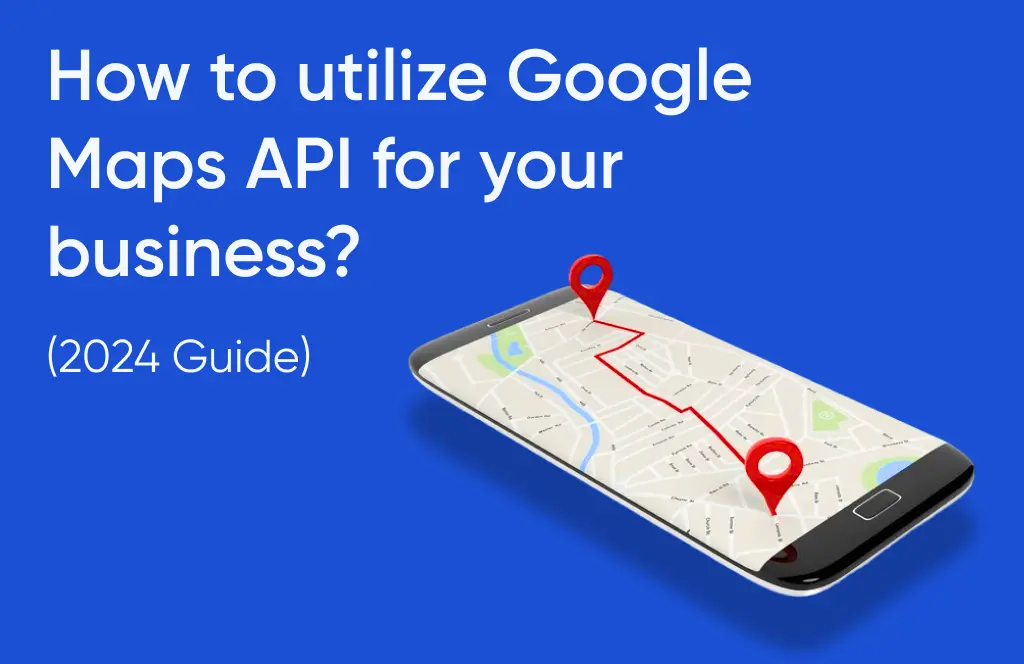When discussing website performance, UX and CRO have become increasingly popular terms. In both cases, the end user is the focus, analytics are used, and feedback is given to meet similar end goals. The terms are sometimes used interchangeably but are different and not identical.
To fully understand UX and CRO, it’s necessary to define them first.
How do CRO and UX differ?
CRO stands for Conversion Rate Optimization and is the process of optimizing the user experience to increase the revenue of the business. CRO lies at the intersection of UX, Data, and business strategy. It is the process of improving the performance of your website by analyzing data and making changes to improve the user experience. It helps to increase revenue, engagement, and loyalty for businesses through improved customer experiences on their website.
Conversion rate optimization(CRO) services help businesses to understand their customers better by doing thorough data analysis and implementing experimentation to improve conversions. It also helps them identify areas that need improvement so that they can make necessary changes to ensure maximum conversions. With CRO, businesses can improve their website’s performance and generate more revenue in the long run.
UX stands for User Experience Design which focuses on creating a great user experience. This includes making sure the site is easy to use, has a good design, and contains helpful content. When done correctly, UX design can help improve conversions by making it easier for users to find what they’re looking for and persuade them to take action.
UX aims to make it simpler for users to interact with, navigate, and complete important actions on your website, while the goal of CRO aims to help you by making the activities you want more accessible and frequent.
Though CRO and UX cooperate, each differs in its primary objectives:
- Goal
- Approach
- Skill set
Let’s Discuss this in detail:
1) Goal:
CRO is about maximizing the number of people who take a specific action on your website or app. It’s focused on driving conversions, whether making a purchase, filling out a form, or subscribing to a newsletter.
UX design, on the other hand, is focused on creating a seamless user experience. It’s about understanding the user’s needs, behaviors, and motivations and designing an interface that meets those needs.
The primary goals of CRO are business driven, while the goals of UX design are more user-driven
| CRO KPI’s | UX KPIs |
| Tangible | Open-Ended |
| Increasing lead generation | Improving user experience |
| Decreasing bounce rates | Improving visuals |
| Improving conversions | Improving layout |
| Increasing average order value, | Easing the navigation for users |
| many more | |
In most scenarios, the UX goals are used to achieve CRO’s objectives.
2) Approach:
CRO tends to be more data-driven and focused on analytics, while UX is more design-focused. In order to deliver the optimal solution, CRO explores the target market, focuses on their wants and existing issues, and examines rival market solutions. Thus, it is critical to identify any potential leaks in the present conversion funnel, test solutions for them, and boost retention rates, resulting in effective conversion and revenue growth for the company.
CRO’s Cyclic process comprises five major steps:
- Analysis
- Hypothesis
- Design
- Integration
- Test.
While the UX method focuses on the reasons behind a user’s actions as they navigate a website. Such behavior is influenced by the user’s experience, his or her sentiments, and the reasons behind why they do certain behaviors. UX specialists do their research, interviews, and usability tests. Ux processes are short and a very integral part of the CRO process.

The major difference between both processes is when the testing is done. In the CRO process, A/B testing or other Testing methods are used at the end to validate which design is performing better. In UX design, testing is usually done to develop prototypes and design variations.
“CRO, or Conversion Rate Optimization, focuses on using data analysis and measurement to implement effective strategies that increase customer conversions and generate higher revenue. It’s all about understanding the reasons behind a user’s intentions, which is where UX, or User Experience, comes into play. UX helps in comprehending user behavior and designing experiences that align with their needs and preferences. Together, CRO and UX work hand in hand to drive business success.”
Hence, it seems that integrating the fundamentals of UX with the fundamentals of CRO will result in the optimal solution design.
3) Skillset:
CRO and UX design are two disciplines that require a unique set of skills. CRO experts are responsible for optimizing the website or product to achieve specific goals. They use a data-driven approach to analyze areas of improvement to gather useful insights that can help conduct meaningful experiments. Therefore CRO experts need to have a strong understanding of specific skillsets like
- Statistics,
- Data Analysis, and
- Web analytics tools like Google Analytics or Hotjar and other data analysis tools.
They must have a good understanding of A/B testing methodologies and strategic experience to plan and execute experiments after data research.
While a UX designer is responsible for creating a user-centered, intuitive, easy, and visually appealing design. Their primary focus is understanding user behavior and motivation to create the design based on user needs and goals. UX designers must be proficient in skills like:
- Design thinking
- User Research
- User testing methodologies.
- Visual design tools like Figma, Adobe XD, etc
- Prototyping tools
While CRO experts and UX Designers have different areas of expertise, their roles often intersect. A CRO expert may identify areas of the website or product that are causing friction and work with the UX designer to design an improved user interface.
Let us understand the difference between CRO and UX through the example:
Problem Area: Analyse and Redesign the form to improve user engagement and Revenue.
Goal: To Increase page views and conversion of the BTR Form.
Depending on their individual objectives and priorities, a UX designer and a conversion rate optimizer may approach form design differently. In order to ensure a great user experience, a UX designer may concentrate on developing a user-friendly, visually appealing form and simple to navigate. In contrast, a conversion rate optimizer may emphasise creating a form that encourages as many sign-ups or form submissions as possible to increase conversions. They might concentrate on elements like the form’s length and complexity, the quantity and variety of form fields, and the use of persuasion in the form’s language and visual signals.
Step-By-Step Approach of UX Designer and CRO Specialist

A UX Designer and Conversion Rate Optimizer would collaborate on this design to boost the number of users clicking “book a test ride.” In order to streamline the process, the UX designer would concentrate on streamlining the form’s layout and visual appearance. Conversion Rate Optimizer would evaluate data and spot any issues in the meanwhile.

In this case, the optimizer identified a few non-essential fields and removed them, resulting in a more streamlined process. The UX Designer agrees that fewer steps in the form are better and more user-friendly. However, in this case, the Conversion Rate Optimizer added a step, making it a two-step process, which increased the conversion rate by 51%.
So why do you need both CRO and UX? The answer is simple: because they both play an important role in the overall success
Why do we need CRO along with UX?
By integrating CRO and UX, businesses can craft an optimal website that not only provides a delightful user experience but also generates higher revenue. Leveraging data-driven insights, businesses can create designs that offer the maximum return on investment (ROI) by focusing on conversion rate optimization (CRO). This seamless blend ensures that our users enjoy a satisfying UX while helping you achieve business goals of increased revenue and customer satisfaction.
Let’s see how CRO can assist UX:
- Introducing the culture of thoughtful experimentation along with UX strategy.
- Leveraging data analysis to identify and prioritize design issues.Optimizing design according to device capability.
- When designing websites that convert, it’s important to take a user-centric approach. This means creating experiences that are not only easy to use and navigate but also provide the functionality that users are looking for. However, simply focusing on UX design is not enough – you also need to consider conversion rate optimization (CRO), which would increase revenue. Advantages of merging UX Design and CRO:
- Increased conversions: You’ll see a noticeable increase in conversions by improving the user experience and conversion rate. This may result in increased purchases, sign-ups, etc
- Increased customer satisfaction: Customers are more likely to be satisfied with your brand when they have a delightful experience on your website. This would result in increased brand trust, which would improve word-of-mouth advertising.
- Improved ROI: When you prioritize UX design and CRO, you’re more likely to get a higher return on investment (ROI). This is because you are raising conversions while ensuring the quality of the leads or customers you convert.
- Reduced costs: You can lower acquisition costs per user by enhancing user experience and flow.
conclusion
understanding the differences between CRO and UX is crucial for leveraging both disciplines to achieve success. While CRO focuses on optimizing the user experience to increase revenue, UX design aims to create a seamless and user-centric interface. CRO relies on data analysis and experimentation, while UX is more design-focused. Despite their distinct approaches, integrating the fundamentals of UX with CRO leads to optimal solution design







